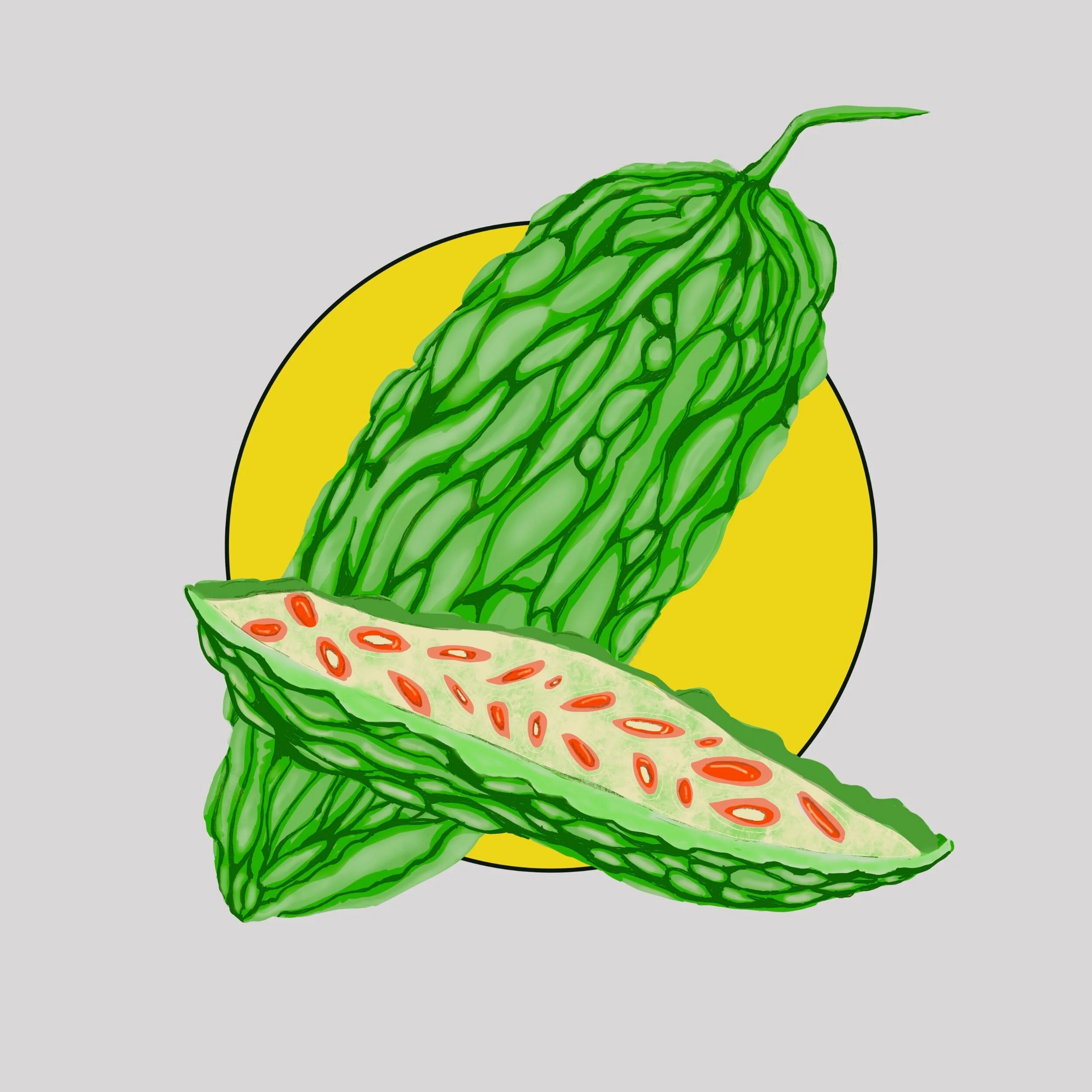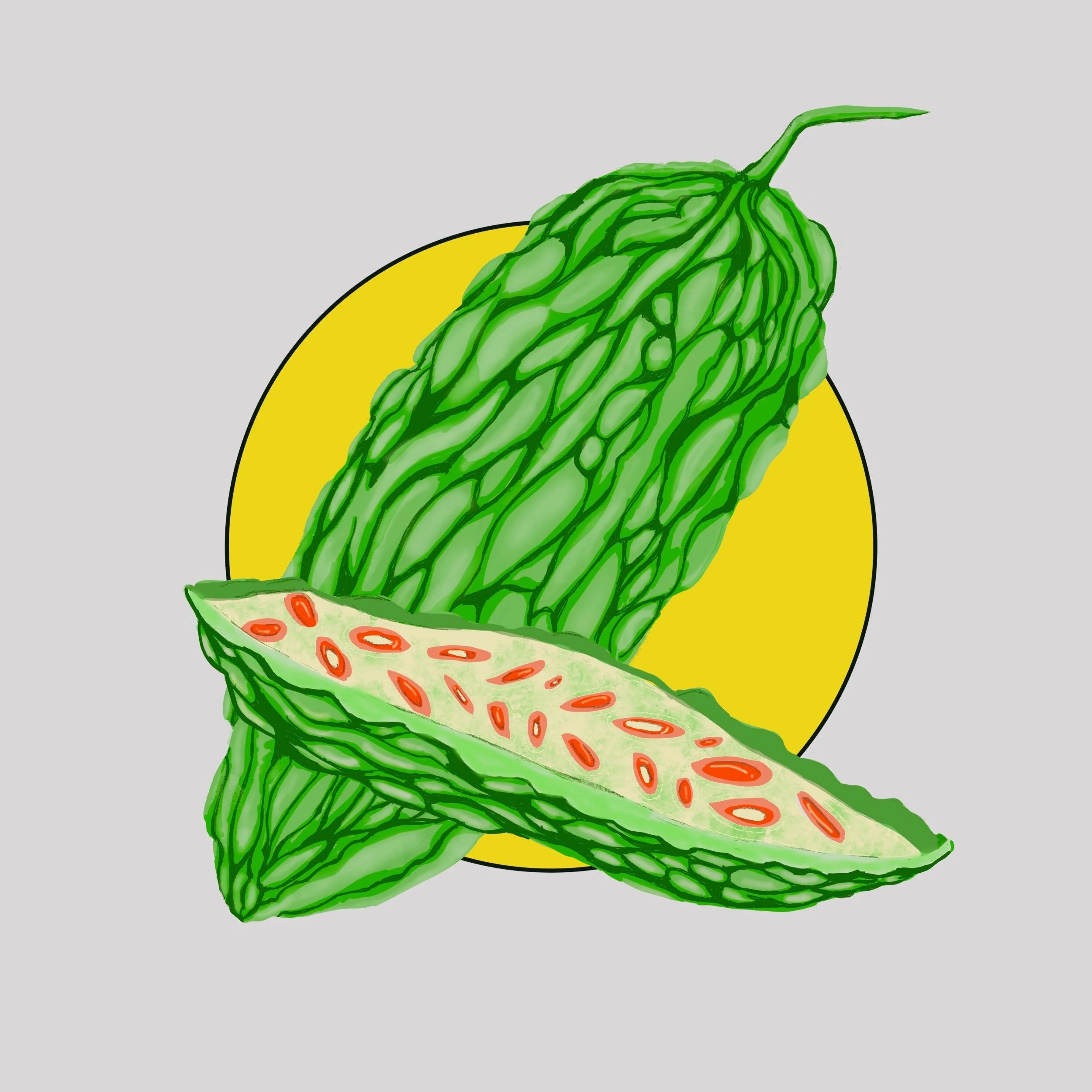Bitter Melon: Can It Be... Poisonous?
Momordica charantia
Photograph of a white variety of bitter gourd taken by Kevin D. Healey (author).
Family — Cucurbitaceae
Family Characteristics — [1] — Members of this family have 5 united-petals on their funnel-shaped flowers which are segregated male from female. Male flowers have 5 (sometimes 3) stamina which are sometimes twined together. Female flowers have an inferior ovary with 3 (or 4) united carpels.
Aliases — Balsan Apple, Balsam Pear, Balsam Vine, Monk Fruit (English); Karela (Hindi); Carllie (Trinidad); Atmagosu (Guam); Lo Han Guo, Lo Han Kuo, Pria Paddy, Foo Gwa, K'u kua, Lai kua {meaning: leprosy gourd} (China); Cerasee (Jamaica); Margose (French colonies); Papari, Pepare, Pare, Paria, Palia, Pania, Pulia, Peria, Papariano, Taparipong, Karaidno, Paridne, Paliak, Pentu, Pepdreh, Vaja, Truwuk, Kambeh, Popari, Foria, Apalaya, Ampalaya, Apalia, Amargoso, Almagoso, Margoso, Pupuruvi (Unspecified "Pacific Islands"); Sorosí (Costa Rica); kokouli (Dominica); Cundeamor (Dominican Republic); Sorosí (Guatemala); Calaica (Honduras); Asorosi (Haiti); Cundeamor (Puerto Rico); Popololo, Corailee, Sorrow Seed (Trinidad/Tobago); Cundeamor (Venezuela); Amargoso (Spanish-Filipino); Saligum (Basilan); Ampalaya (Manila, Tayabas, Balabac Island); Ampaleya (Bataan); Apalya (Marinduque) ; Maragoso (Surigao) ; Parid (Camarines) ; Pariam (Bontoc)
Binomial Etymology — Momordi- is a prefix derived from the proto-Italian term, mordeo, which means: to bite; charantia means "beautiful flower" [14].
Binomial Pronunciation: —Moe-more-dik-ah ~ Shar-ahnt-shah
USDA Classification — Introduced
Introduction
Do you take me to be a Bitter Gourd, content to merely hang on a string without ever being eaten?
Analects of Confucius (475-221 B.C.)
Any quote taken from any ancient book of philosophical or theological importance will carry with it hundreds — if not thousands — of conflicting interpretations. As told through the words of scholars, Confucius may have been referring to an ancient Chinese practice of hollowing out and drying the bitter gourd to be used as a drinking vessel, or that the "bitter gourd" term should actually be translated as a star that hangs in the sky to be admired but not eaten [7]. Making a definitive choice as to the true meaning of the original ancient Chinese statement is beyond my authority, however, careful subjective interpretation often lends the most insight into one's own inner world.
Such confusion seems to follow Momordica charantia wherever it goes.
The topography of the Momordica charantia fruit is as static as an unquiet sea, and its story is just as noisy. It is a plant summarily known as a worthless miracle, or a welcome pest who's fruit is described as a disgusting delicacy which is either intolerably or pleasantly bitter when underripe... depending on who is answering. This is confusing enough, however, it gets worse.
By far, the most incoherent assertions made by reputable sources have to do with the bright-red arils that surround the seeds: some authorities say they are sweet, delicious, and outstandingly nutritious, while others warn that they are extremely poisonous. We will explore the record to see which assertion holds more water.
One item remains certain: Momordica charantia has been used — across many cultures — as a food and medicine for thousands of years.
Like any philosophical problem, the most consequential answer ultimately comes from inside yourself. So, I guess, the real question of this article is:
What is the bitter gourd to you?
Welcome aboard, Jack! Together, with the boat-wheel spinning on its helm, we shall traverse the unquiet seas of Momordica charantia: the amorphous fruit with an amorphous story.
Description
The deeply lobed palmate leaves are arranged in an alternate fashion along the vine. Both the tendrils and flowers are axillary, and young shoots present as pubescent. The plant presents with separate male and female flowers with five-lobbed calyxes below the five yellow petals. Male flowers present with a conspicuous cup-shaped bract, and the female flowers present with a pretty obvious inferior ovary. The flowers are very fragrant. The young fruit is green and warty, and ripens to a bright yellow color before opening to reveal lipstick-red aril-coated seeds.
Is the Bitter Melon Poisonous?
To some palates, the underripe bitter gourd is best prepared by tossing it into a fire, collecting the ashes, and dumping them unceremoniously into the deadest part of the ocean.
To other palates, the green bitter gourd is a relished food that brings back fond memories of childhood.
By all accounts, the leaves and underripe fruits can be eaten by human beings that do not wish to become violently ill: this is an important consideration. When the fruit ripens and the juicy arils which encapsulate the seeds turn a vibrant lipstick-red color, well, that's where the consensus ends.
Image, taken by Alex Popovkin, retrieved under Creative Commons licensure from here.
North Carolina State Extension lists M. charantia as a poisonous plant; going so far as to name the toxic principles surrounding the seeds of the ripe fruit as "resin, saponic glycoside, and alkaloids" [9]. While they allow that the arils are only toxic when consumed in large quantities, they claim that the poisoning can manifest in the following way: you notice you have a headache and you begin to drool. As your stomach begins to ache, you grow increasingly concerned. You look into the mirror and notice your face is fire-engine-red, and your pupils have dilated black. Uh-oh! Suddenly you are met with a serious urge to rush to the toilet where you vomit into a bucket and experience explosive diarrhea simultaneously [9]. This does not equal fun, however, I found no source citations for these claims.
A 2017 study funded by Konkuk University (Republic of Korea) not only professed the edibility of the red seed arils, but found they contained outstandingly high levels of lycopene (antioxidant) as well as α-linolenic acid and linoleic acid (polyunsaturated fatty acids that aid in cardio protection and inflammatory response modulation) [11]. In their study, the claim to the edibility of Momordica charantia seed arils was made unambiguous: "...edible seed arils of bitter melon fruit made up an average of 10–20% of the total ripened fruit weight"[11].
Further, according to the Malaysian National Poison Center at Universiti Sains Malaysia [12]:
"...the pith will become sweet when the fruit is fully ripe, and the pith's color will turn red. The pith can be eaten uncooked in this state, but the flesh of the melon will be far too tough to be eaten anymore. Red and sweet bitter melon pith is a popular ingredient in some special southeast Asian style salad."
I've found other sources which I personally deem credible touting the edibility of the ripe fruit (one source even eats the red arils on camera like she had done it 1,000 times). However, without a full consensus, trying the red arils of the ripe fruit should be done with caution and moderation, if at all.
The Bitter Gourd by Sophia Fernandez (2021) C/O signalofspirit.com
Ethnobotany
M. charantia is considered an anti-parasitic digestive stimulant that both arouses the appetite and functions as a laxative in Asian and African pharmacopoeia [2]. Momordica spp. have additionally been used as a purgative, aphrodisiac, fever reducer, burn treatment, blood glucose regulator, hypertension fighter, liver tonic, snake bite remedy, and a hemorrhoid treatment as well as a general promotor of health and longevity [2].
In China, eating cooked bitter melon is said to curb the negative effects of eating too much fried food in hot weather [5].
In Jamaica, a tea is made of the plant to curb "hot belly," and to aid in alleviating symptoms of a cold [6]. The bitter properties of the plant were once thought to have similar actions against malaria as quinine in 19th century French colonies [7].
Tribal peoples living in the Chitteri Hills of India juice the fruit to help treat people with diabetes [10]. This is a common, and well studied use for the plant. In India, among the locals of Calcutta, the plant was known as a specific against leprosy and cancer [13].
Pharmaceutical effects
[To Be Continued]...
Literature
Oh ! Ann, Ann, well art thou
called the Bitter Gourd, for bitter art thou to me.
The Honeycomb and Bitter Gourd by Allen Cunningham (1829)
Do you take me to be a Bitter Gourd, content to merely hang on a string without ever being eaten?
The Analects of Confucius
The Bitter Gourd I planted where Sago
Heaps had lain.
With Treacle-drops and Honey I
drenched the Little Hill;
I trained the Leafy Tendrils on rods of
Sugar Cane;
But when the Fruit had ripened, alas!
'twas Bitter still!
Chinese Proverb [4]
Nutrition
Cucurbits are not usually known for their nutritive value, but M. charantia has shown to contain both vitamin C and iron [2].
Image retrieved from USDA website, from here, showing nutrition from boiled and drained bitter melon fruit without salt.
Recipes
Hey, Weird Fruit Explorer mentioned this article! Alright!
This is apparently a customary way to cook bitter melon in Trinidad.
STUFFED BITTERGOURD BY MASTANAMMA… I could watch this lady cook all day long.
Miscellaneous
M. charantia prefers slightly acidic soil conditions (pH 6-6.5) and there is a 50-60 day lag between planting and harvest [2]. All Momordica species are thought to have originated in tropical Africa and spread to Asia via a single long-distance transport some 19 million years ago [2]. Amazing!
Weird Facts
Simply type "bitter melon challenge" in your youtube search box and you will find hours of videos dedicated to people stuffing their mouths with raw bitter melon.
Pull Up Your Plants! (PUYP) is now receiving visits from all over the world! Please take the time to leave a comment or subscribe below. I’d like to hear about your experiences with …
For source citations, please email Kevin Healey at
pullupyourplants. @ gmail.com
With Love,
Kevin.








